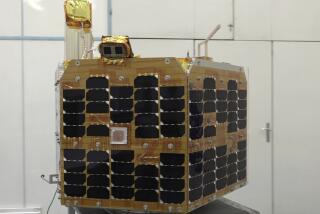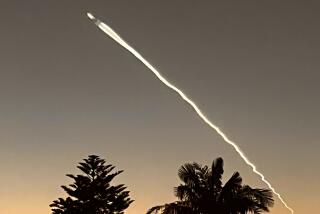Shuttle Launches Arab League Satellite : Second Deployment Bolsters NASA Struggle to Prove Reliability
- Share via
HOUSTON — The crew of the space shuttle Discovery made its second successful satellite launch Tuesday, bolstering the National Aeronautics and Space Administration in its struggle to prove that its space transportation system is a reliable means of orbiting satellites.
The crew was scheduled to try to make it three in a row today with the launch of a satellite owned by American Telephone & Telegraph.
The shuttle satellite program was set back in April when a Navy satellite failed to activate and was left stranded in space after an unsuccessful rescue attempt. Another attempt to rescue the craft is scheduled to be made by a shuttle crew this August.
The communications satellite launched Tuesday, called Arabsat, is owned by the 22 members of the Arab League, which includes Libya and the Palestine Liberation Organization. It is the second Arabsat now in orbit. The first was launched last February by the shuttle’s principal competition, the European Space Agency rocket Ariane, and the head of the Arab project made it clear here Tuesday that whoever comes up with the best price will get his agency’s business in the future.
‘Economic Factor’
“It all depends on the economic factor,” said Ali Al-Mashat, director general of Arabsat.
Mashat said the Ariane launch cost $23 million, compared with the shuttle’s $20.5 million. Arabsat owns a third satellite and will launch it if one of the two now in orbit fails.
That statement was made as NASA tried to set the price for future launches, subject to the approval of President Reagan. Some private corporations want to establish commercial launch programs and would like to see the shuttle’s price set high enough to encourage competition, but NASA officials fear that a price that high would drive all business overseas. Communication satellites are the only significant source of commercial space revenues.
Mashat said Saudi Arabia is the largest shareholder in Arabsat. The PLO is the smallest, he said, with only 0.2% of the shares.
Important to Prince
The Arabsat launch was especially important for one member of the Discovery’s crew, an Arab prince who is a nephew of King Fahd of Saudi Arabia. Sultan ibn Salman al Saud, 28, who is aboard the shuttle as part of NASA’s policy to carry representatives of companies or countries that do business with the space agency, compared the Arabsat deployment with Monday’s launch of Morelos, owned by Mexico.
“It looked much better than the Morelos deployment,” Prince Sultan said, “but that may have been a biased opinion.”
The prince also had something else to celebrate while orbiting above the Earth, but it did not work out the way some had expected.
The Muslim holy month of Ramadan officially ended when the first Muslim saw the new moon early Tuesday, and it had been expected that the prince would make the sighting, aided by his high altitude.
But astronaut David Leestma at Mission Control told the prince early Tuesday that the new moon had been sighted by someone in Saudi Arabia, signaling the end of the holiest month in the Muslim year.
Able to Break Fast
During Ramadan, devout Muslims do not eat or drink until sunset, and although he was not the first to see the new moon, Prince Sultan was able to join other Muslims in breaking fast.
“Well, thanks very much,” the prince told Leestma. “That’s good news because I’m really starving up here and thirsty.”
At about 11:30 a.m. today, Discovery commander Daniel C. Brandenstein, 42, and pilot John O. Creighton, 42, will maneuver the craft into position for the shuttle’s first encounter with Reagan’s “Star Wars” missile defense research effort. An eight-inch mirror will be placed against one of the Discovery’s windows to serve as a reflector for a low energy laser beam from the Hawaiian island of Maui.
The experiment is designed to determine if lasers can be used to track “targets” moving at 17,400 m.p.h. in low-Earth orbit.
The other members of the crew are mission specialists Steven R. Nagel, 38; John M. Fabian, 46, and Shannon W. Lucid, 42, and French astronaut Patrick Baudry, 39.
More to Read
Sign up for Essential California
The most important California stories and recommendations in your inbox every morning.
You may occasionally receive promotional content from the Los Angeles Times.










